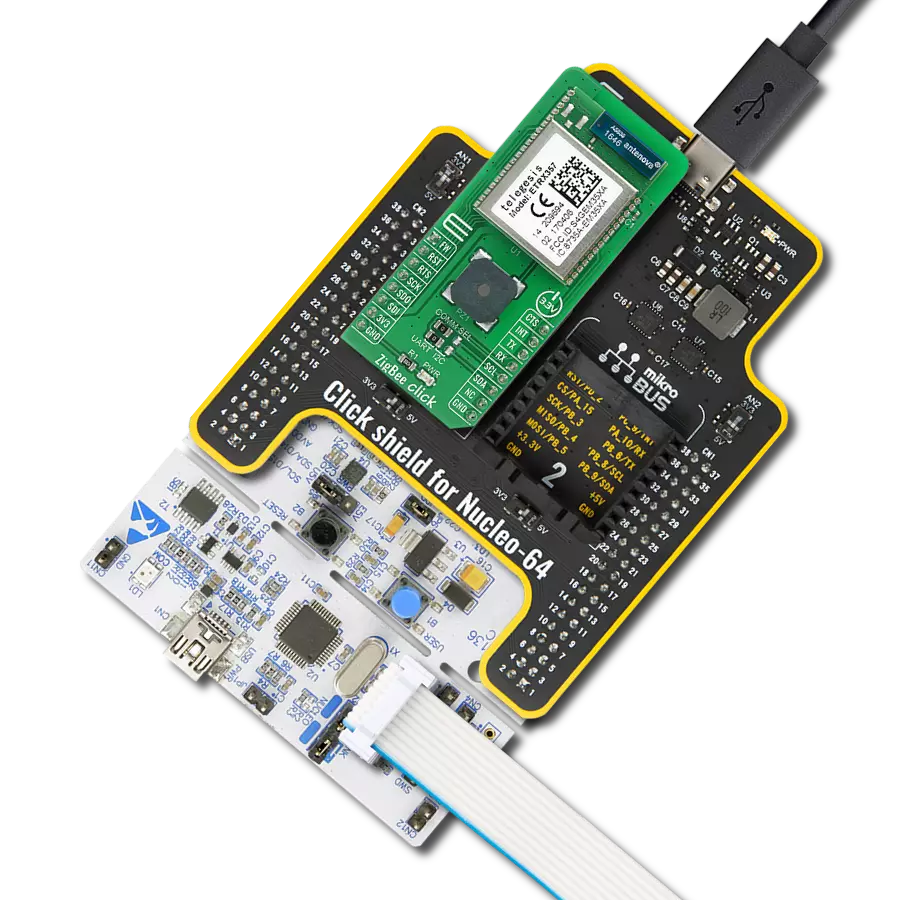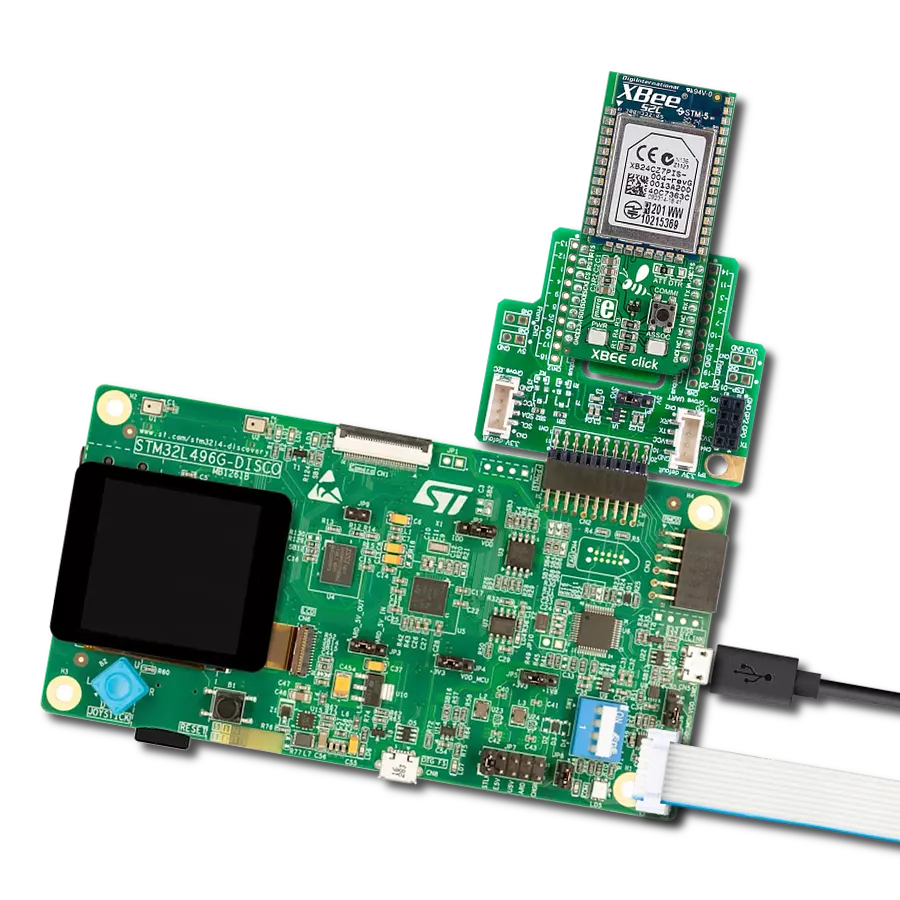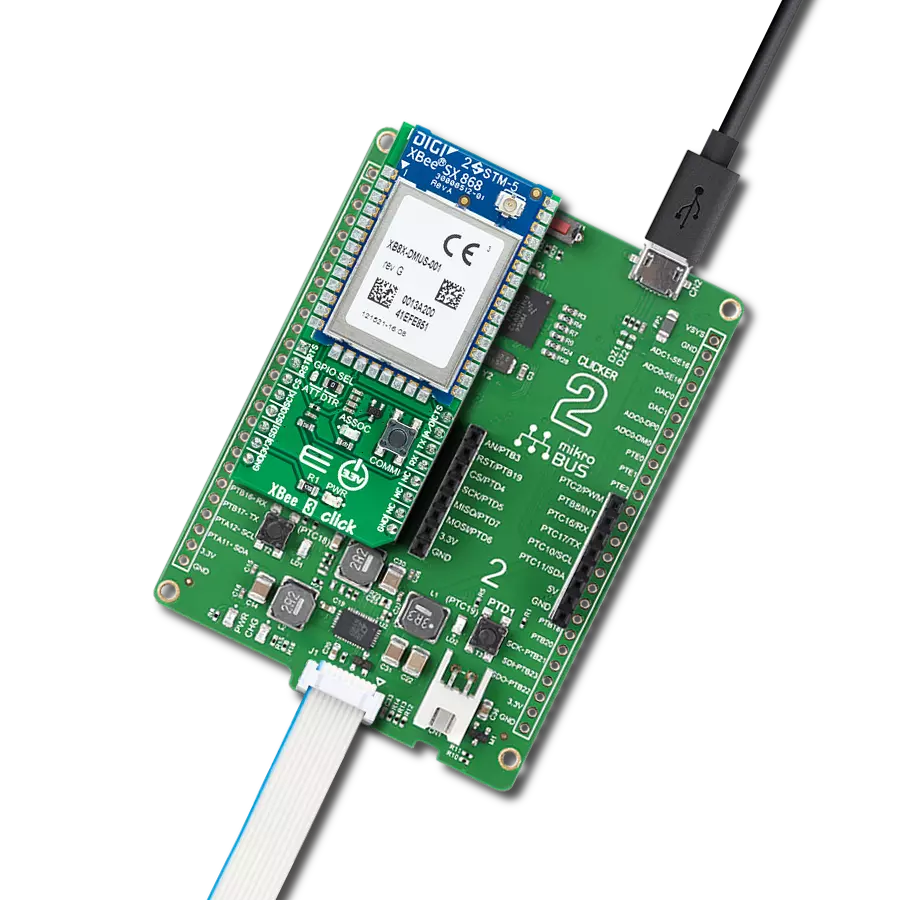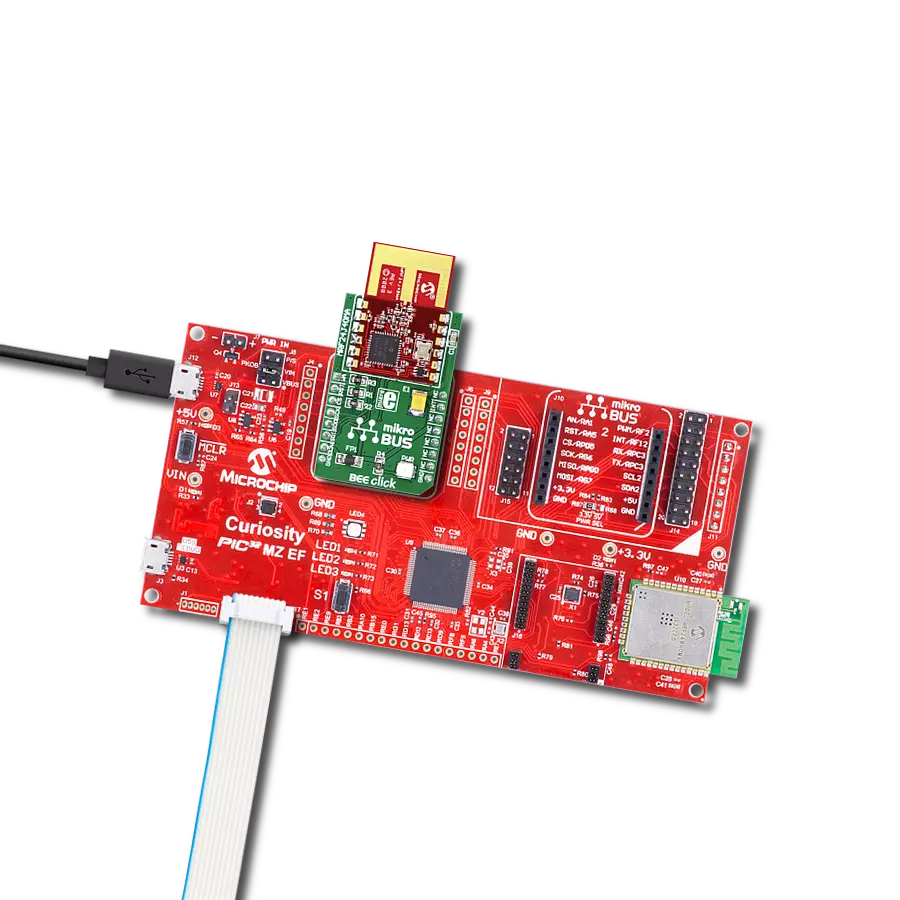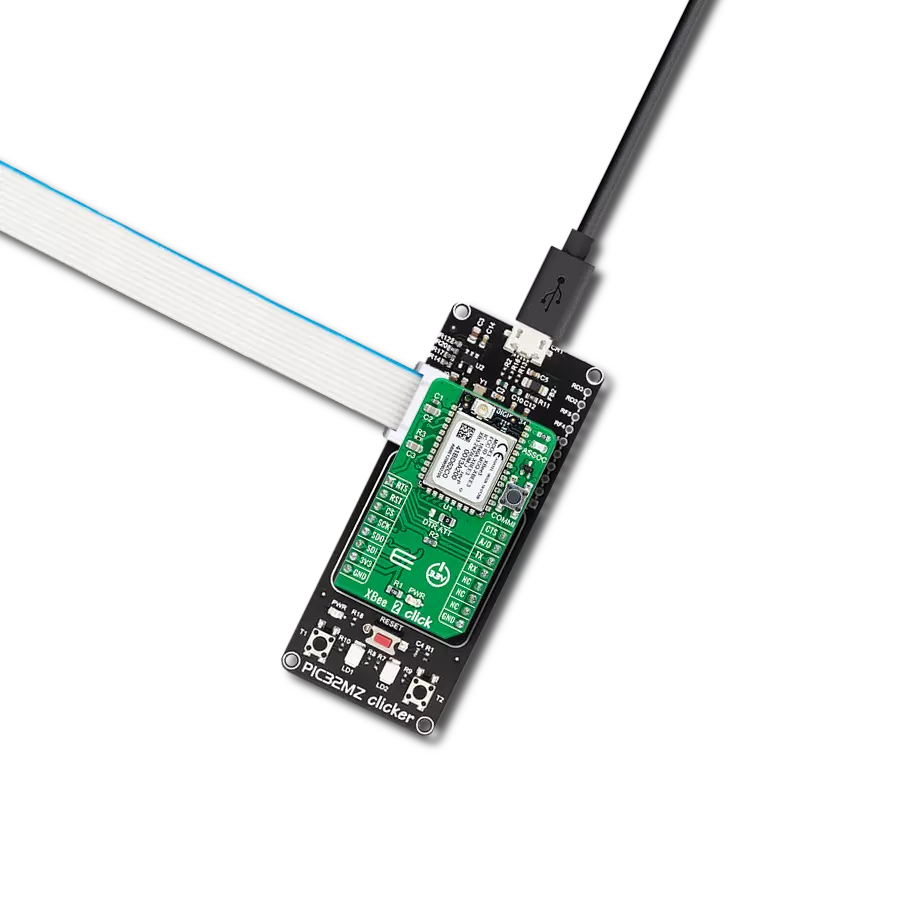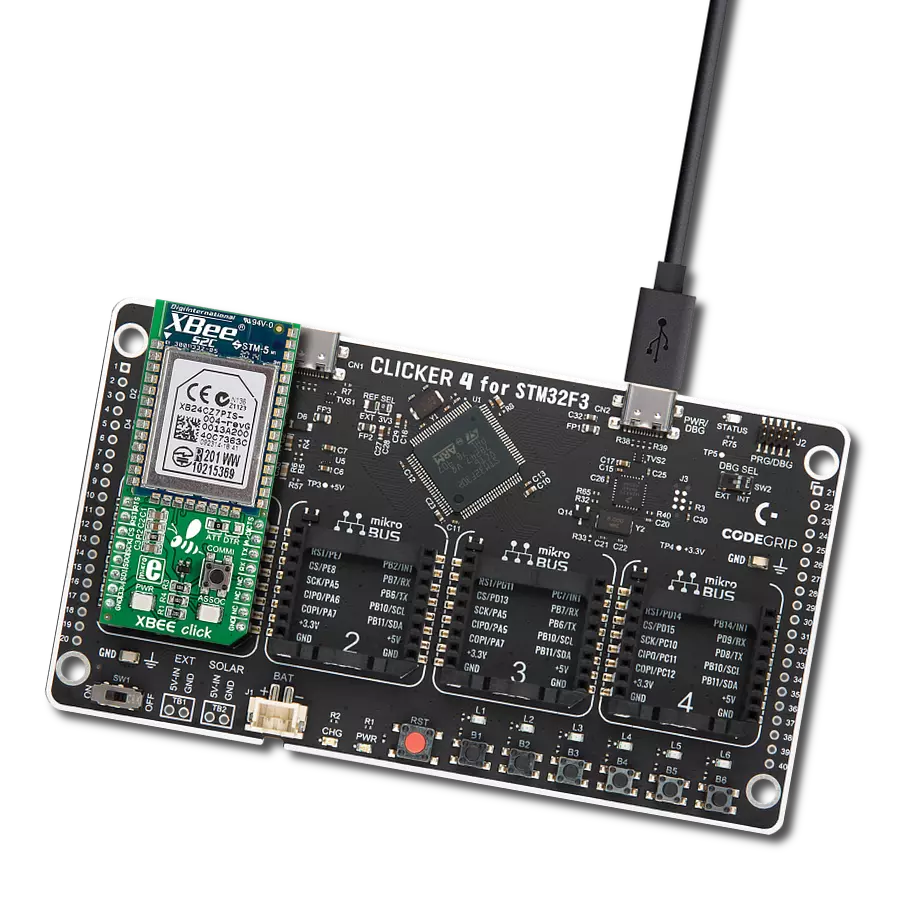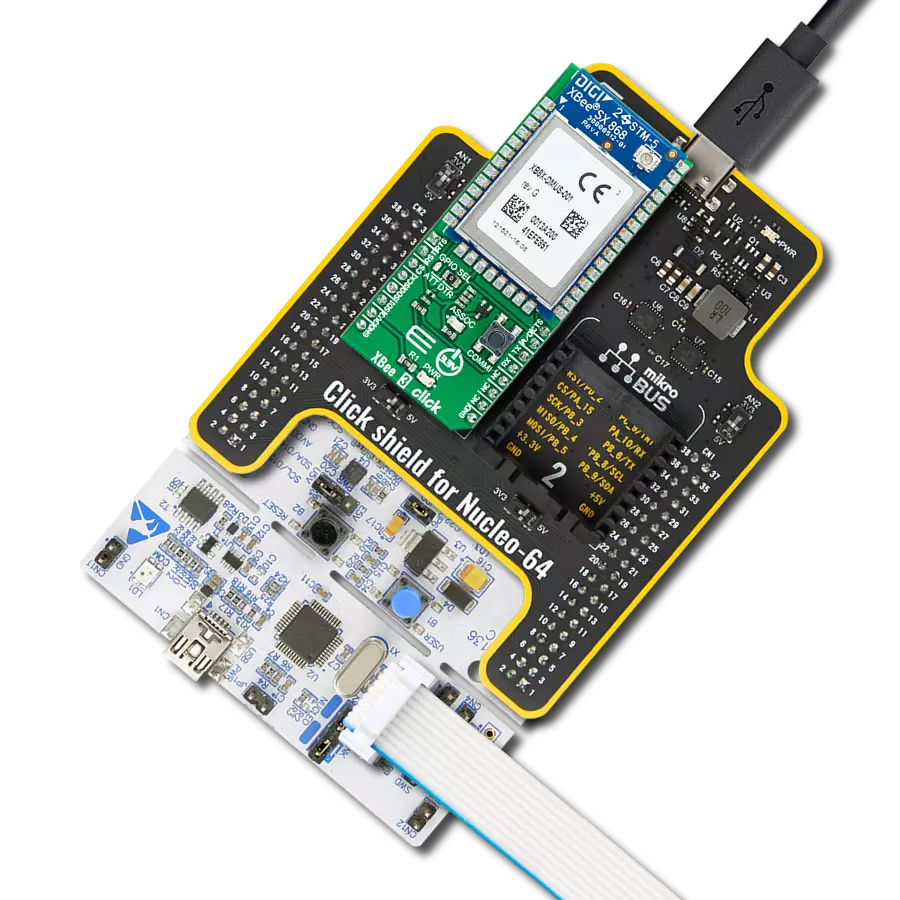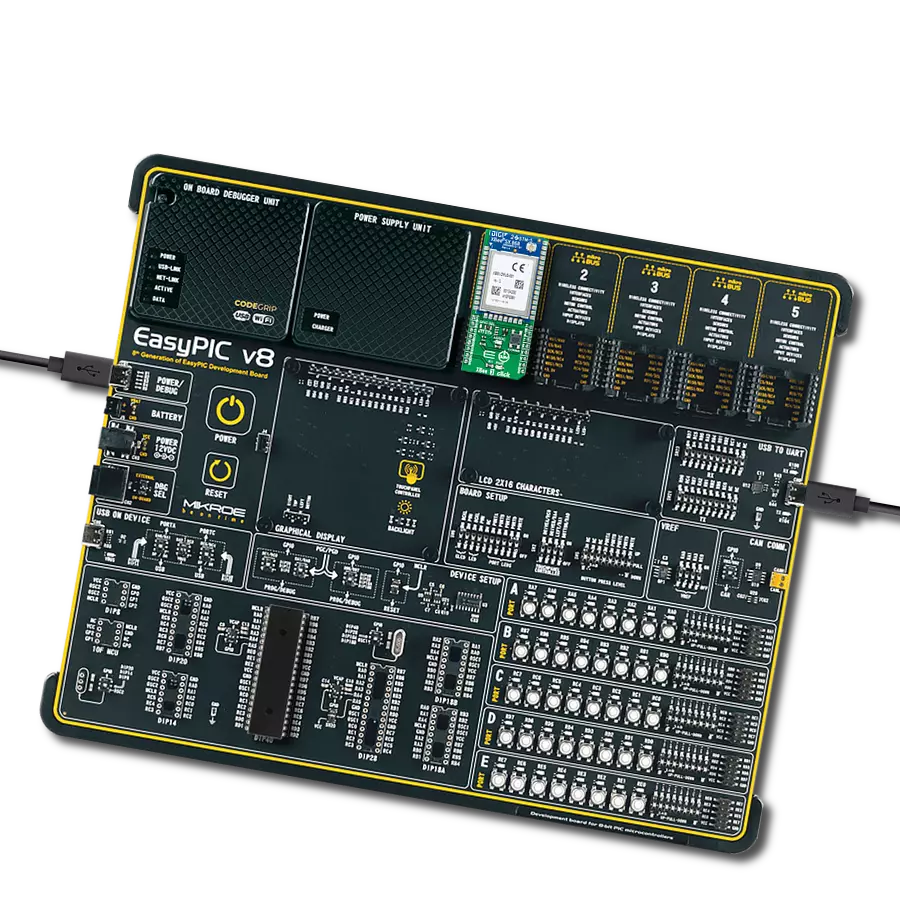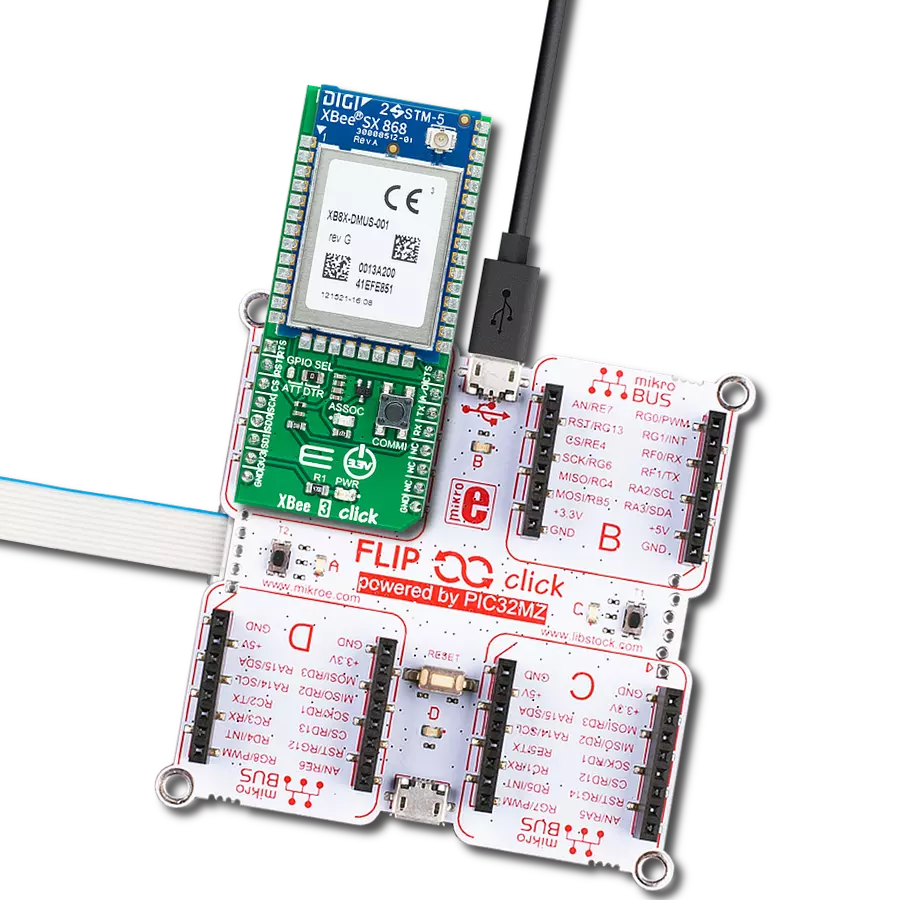Secure and reliable wireless connectivity for various M2M and IoT devices
A
A
Hardware Overview
How does it work?
XBee 3 Click is based on the XB8X-DMUS-001, a Digi XBee® CE/RED certified RF module suitable for mission-critical wireless applications from Digi International. The XB8X-DMUS-001 can run a proprietary DigiMesh® or point-to-multipoint networking protocol utilizing a low-power Silicon Labs MCU and an ADF7023 transceiver with an integrated SAW filter offering industry-leading interference blocking. It also supports low-power sleeping nodes and has an RF line-of-sight range of up to 14km (rural range line of sight) in a combination of coverage, data redundancy, and data reliability. The XB8X-DMUS-001 module is pre-certified for use in European countries. Operating between 863MHz and 870MHz (868MHz), it allows use in several regions, including approved European countries. It also leverages surrounding frequencies for LBT+AFA (Listen-Before-Talk and Adaptive-Frequency-Agility), significantly reducing interference by listening to the radio environment before any transmission starts and automatically shifting to a new channel when interference is
detected. This Click board™ comes with a configurable host interface allowing communication with MCU using the chosen interface. The XB8X-DMUS-001 can communicate with MCU using the UART interface with commonly used UART RX, TX, and hardware flow control pins UART CTS and RTS (Clear to Send and Ready to Send) or using the SPI interface (XBee module will work as an SPI-slave only). In the case of the SPI interface, the users can use it to configure the module and write the library by themselves. The XBee 3 Click is associated with many other features, such as the reset function and the possibility of visual and digital indicators. An active-low reset signal routed on the RST pin of the mikroBUS™ socket activates a hardware reset of the system, while a yellow LED indicator marked as ASSOC represents a visual indication of the module's connection to the network. If the LED is constantly on, it means that the module is not connected to the mobile network, while the standard flashing of the LED represents the normal operating mode. The A/D pin of the mikroBUS™ socket
represents a type of interrupt whose function can be selected by positioning an onboard SMD jumper to an appropriate position labeled as DTR or ATT. DTR position is a "Data terminal ready" function used to tell the XBee module that the host MCU is ready to communicate, while the ATT position (SPI Attention) represents an indicator for the SPI interface whenever the XBee module has data for the host MCU. In addition, the board also has a commissioning pushbutton marked as COMMI, which, combined with an ASSOC LED, provides various simple functions to aid in deploying devices in a network. This Click board™ can only be operated from a 3.3V logic voltage level. Therefore, the board must perform appropriate logic voltage conversion before using MCUs with different logic levels. However, the Click board™ comes equipped with a library containing functions and an example code that can be used as a reference for further development.
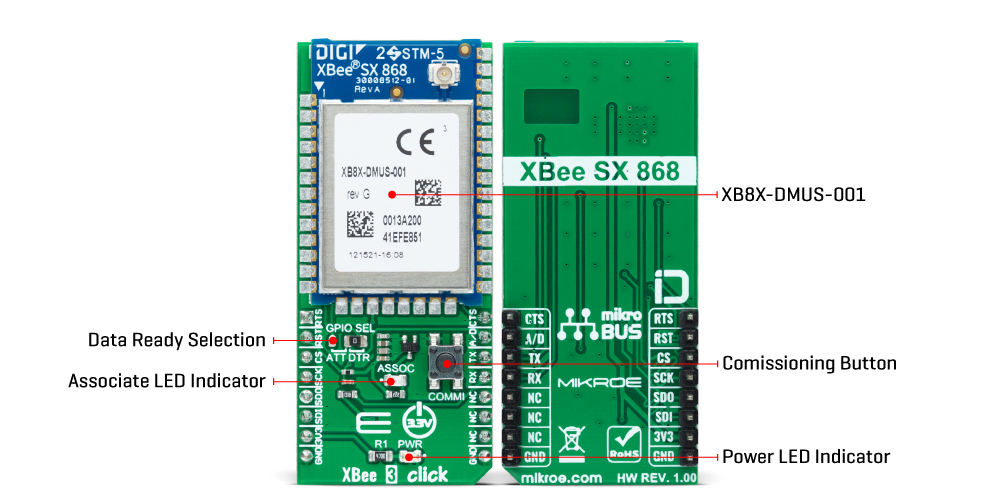
Features overview
Development board
Nucleo-64 with STM32F446RE MCU offers a cost-effective and adaptable platform for developers to explore new ideas and prototype their designs. This board harnesses the versatility of the STM32 microcontroller, enabling users to select the optimal balance of performance and power consumption for their projects. It accommodates the STM32 microcontroller in the LQFP64 package and includes essential components such as a user LED, which doubles as an ARDUINO® signal, alongside user and reset push-buttons, and a 32.768kHz crystal oscillator for precise timing operations. Designed with expansion and flexibility in mind, the Nucleo-64 board features an ARDUINO® Uno V3 expansion connector and ST morpho extension pin
headers, granting complete access to the STM32's I/Os for comprehensive project integration. Power supply options are adaptable, supporting ST-LINK USB VBUS or external power sources, ensuring adaptability in various development environments. The board also has an on-board ST-LINK debugger/programmer with USB re-enumeration capability, simplifying the programming and debugging process. Moreover, the board is designed to simplify advanced development with its external SMPS for efficient Vcore logic supply, support for USB Device full speed or USB SNK/UFP full speed, and built-in cryptographic features, enhancing both the power efficiency and security of projects. Additional connectivity is
provided through dedicated connectors for external SMPS experimentation, a USB connector for the ST-LINK, and a MIPI® debug connector, expanding the possibilities for hardware interfacing and experimentation. Developers will find extensive support through comprehensive free software libraries and examples, courtesy of the STM32Cube MCU Package. This, combined with compatibility with a wide array of Integrated Development Environments (IDEs), including IAR Embedded Workbench®, MDK-ARM, and STM32CubeIDE, ensures a smooth and efficient development experience, allowing users to fully leverage the capabilities of the Nucleo-64 board in their projects.
Microcontroller Overview
MCU Card / MCU
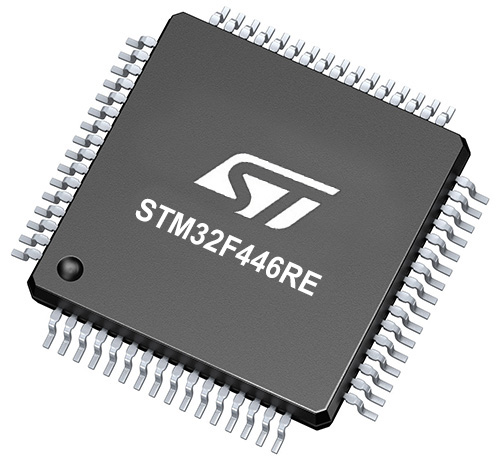
Architecture
ARM Cortex-M4
MCU Memory (KB)
512
Silicon Vendor
STMicroelectronics
Pin count
64
RAM (Bytes)
131072
You complete me!
Accessories
Click Shield for Nucleo-64 comes equipped with two proprietary mikroBUS™ sockets, allowing all the Click board™ devices to be interfaced with the STM32 Nucleo-64 board with no effort. This way, Mikroe allows its users to add any functionality from our ever-growing range of Click boards™, such as WiFi, GSM, GPS, Bluetooth, ZigBee, environmental sensors, LEDs, speech recognition, motor control, movement sensors, and many more. More than 1537 Click boards™, which can be stacked and integrated, are at your disposal. The STM32 Nucleo-64 boards are based on the microcontrollers in 64-pin packages, a 32-bit MCU with an ARM Cortex M4 processor operating at 84MHz, 512Kb Flash, and 96KB SRAM, divided into two regions where the top section represents the ST-Link/V2 debugger and programmer while the bottom section of the board is an actual development board. These boards are controlled and powered conveniently through a USB connection to program and efficiently debug the Nucleo-64 board out of the box, with an additional USB cable connected to the USB mini port on the board. Most of the STM32 microcontroller pins are brought to the IO pins on the left and right edge of the board, which are then connected to two existing mikroBUS™ sockets. This Click Shield also has several switches that perform functions such as selecting the logic levels of analog signals on mikroBUS™ sockets and selecting logic voltage levels of the mikroBUS™ sockets themselves. Besides, the user is offered the possibility of using any Click board™ with the help of existing bidirectional level-shifting voltage translators, regardless of whether the Click board™ operates at a 3.3V or 5V logic voltage level. Once you connect the STM32 Nucleo-64 board with our Click Shield for Nucleo-64, you can access hundreds of Click boards™, working with 3.3V or 5V logic voltage levels.
Used MCU Pins
mikroBUS™ mapper
Take a closer look
Click board™ Schematic

Step by step
Project assembly
Software Support
Library Description
This library contains API for XBee 3 Click driver.
Key functions:
xbee3_get_serial_numberThis function sends a get serial number command.xbee3_set_device_nameThis function sets the device name (node identifier).xbee3_set_destination_addressThis function sets the destination address high and low bytes.
Open Source
Code example
The complete application code and a ready-to-use project are available through the NECTO Studio Package Manager for direct installation in the NECTO Studio. The application code can also be found on the MIKROE GitHub account.
/*!
* @file main.c
* @brief XBEE 3 Click Example.
*
* # Description
* This example demonstrates the use of an XBEE 3 Click board by showing
* the communication between the two Click boards configured in transparent mode.
*
* The demo application is composed of two sections :
*
* ## Application Init
* Initializes the driver and configures the Click board by performing a factory reset,
* and setting the device name, destination address, and api mode to transparent.
*
* ## Application Task
* Depending on the selected application mode, it reads all the received data or
* sends the desired message every 3 seconds.
*
* ## Additional Function
* - static void xbee3_clear_app_buf ( void )
* - static err_t xbee3_process ( void )
* - static err_t xbee3_display_rsp ( uint16_t timeout )
*
* @author Stefan Filipovic
*
*/
#include "board.h"
#include "log.h"
#include "xbee3.h"
// Device name (Node identifier).
#define DEVICE_NAME "XBEE 3 Click"
// Enter here the specific serial number high and low bytes of the remote device as a hex string or
// leave it set to broadcast addresses for forwarding messages to all devices
#define DESTINATION_ADDRESS_HIGH XBEE3_BROADCAST_DEST_ADDRESS_HIGH
#define DESTINATION_ADDRESS_LOW XBEE3_BROADCAST_DEST_ADDRESS_LOW
// Comment out the line below in order to switch the application mode to receiver
#define DEMO_APP_TRANSMITTER
// Text message to send in the transmitter application mode
#define DEMO_TEXT_MESSAGE "MikroE - XBEE 3 Click board\r\n"
// Application process buffer size
#define PROCESS_BUFFER_SIZE 200
static xbee3_t xbee3;
static log_t logger;
static char app_buf[ PROCESS_BUFFER_SIZE ] = { 0 };
static int32_t app_buf_len = 0;
static int32_t app_buf_cnt = 0;
/**
* @brief XBEE 3 clearing application buffer.
* @details This function clears memory of application buffer and reset its length and counter.
* @note None.
*/
static void xbee3_clear_app_buf ( void );
/**
* @brief XBEE 3 data reading function.
* @details This function reads data from device and concatenates data to application buffer.
* @return @li @c 0 - Read some data.
* @li @c -1 - Nothing is read.
* @li @c -2 - Application buffer overflow.
* See #err_t definition for detailed explanation.
* @note None.
*/
static err_t xbee3_process ( void );
/**
* @brief XBEE 3 display response function.
* @details This function reads data from device until it sends OK or ERROR message or until
* it exceeds the timeout value.
* @param[in] timeout : Timeout value in miliseconds.
* @return @li @c 0 - Read some data.
* @li @c -1 - Nothing is read.
* See #err_t definition for detailed explanation.
* @note None.
*/
static err_t xbee3_display_rsp ( uint16_t timeout );
void application_init ( void )
{
log_cfg_t log_cfg; /**< Logger config object. */
xbee3_cfg_t xbee3_cfg; /**< Click config object. */
/**
* Logger initialization.
* Default baud rate: 115200
* Default log level: LOG_LEVEL_DEBUG
* @note If USB_UART_RX and USB_UART_TX
* are defined as HAL_PIN_NC, you will
* need to define them manually for log to work.
* See @b LOG_MAP_USB_UART macro definition for detailed explanation.
*/
LOG_MAP_USB_UART( log_cfg );
log_init( &logger, &log_cfg );
log_info( &logger, " Application Init " );
// Click initialization.
xbee3_cfg_setup( &xbee3_cfg );
XBEE3_MAP_MIKROBUS( xbee3_cfg, MIKROBUS_1 );
if ( UART_ERROR == xbee3_init( &xbee3, &xbee3_cfg ) )
{
log_error( &logger, " Communication init." );
for ( ; ; );
}
xbee3_hw_reset ( &xbee3 );
xbee3_process( );
xbee3_clear_app_buf( );
log_printf( &logger, " - Enter command mode -\r\n" );
xbee3_enter_command_mode ( &xbee3 );
Delay_ms ( 100 );
xbee3_display_rsp ( 1000 );
log_printf( &logger, " - Factory Reset -\r\n" );
xbee3_factory_reset ( &xbee3 );
Delay_ms ( 100 );
xbee3_display_rsp ( 1000 );
log_printf( &logger, " - Get serial number -\r\n" );
xbee3_get_serial_number ( &xbee3 );
Delay_ms ( 100 );
xbee3_display_rsp ( 1000 );
log_printf( &logger, " - Set Device Name -\r\n" );
xbee3_set_device_name ( &xbee3, DEVICE_NAME );
Delay_ms ( 100 );
xbee3_display_rsp ( 1000 );
log_printf( &logger, " - Set Destination Address -\r\n" );
xbee3_set_destination_address ( &xbee3, DESTINATION_ADDRESS_HIGH, DESTINATION_ADDRESS_LOW );
Delay_ms ( 100 );
xbee3_display_rsp ( 1000 );
log_printf( &logger, " - Set API mode -\r\n" );
xbee3_set_api_mode ( &xbee3, XBEE3_MODE_TRANSPARENT );
Delay_ms ( 100 );
xbee3_display_rsp ( 1000 );
log_printf( &logger, " - Apply changes -\r\n" );
xbee3_apply_changes ( &xbee3 );
Delay_ms ( 100 );
xbee3_display_rsp ( 1000 );
log_printf( &logger, " - Save changes -\r\n" );
xbee3_save_changes ( &xbee3 );
Delay_ms ( 100 );
xbee3_display_rsp ( 1000 );
log_printf( &logger, " - Exit command mode -\r\n" );
xbee3_exit_command_mode ( &xbee3 );
Delay_ms ( 100 );
xbee3_display_rsp ( 1000 );
app_buf_len = 0;
app_buf_cnt = 0;
#ifdef DEMO_APP_TRANSMITTER
log_printf( &logger, " Application Mode: Transmitter\r\n" );
#else
log_printf( &logger, " Application Mode: Receiver\r\n" );
#endif
log_info( &logger, " Application Task " );
}
void application_task ( void )
{
#ifdef DEMO_APP_TRANSMITTER
xbee3_generic_write( &xbee3, DEMO_TEXT_MESSAGE, strlen( DEMO_TEXT_MESSAGE ) );
log_printf( &logger, "%s", ( char * ) DEMO_TEXT_MESSAGE );
Delay_ms ( 1000 );
Delay_ms ( 1000 );
Delay_ms ( 1000 );
#else
xbee3_process( );
if ( app_buf_len > 0 )
{
log_printf( &logger, "%s", app_buf );
xbee3_clear_app_buf( );
}
#endif
}
int main ( void )
{
/* Do not remove this line or clock might not be set correctly. */
#ifdef PREINIT_SUPPORTED
preinit();
#endif
application_init( );
for ( ; ; )
{
application_task( );
}
return 0;
}
static void xbee3_clear_app_buf ( void )
{
memset( app_buf, 0, app_buf_len );
app_buf_len = 0;
app_buf_cnt = 0;
}
static err_t xbee3_process ( void )
{
int32_t rx_size;
char rx_buf[ PROCESS_BUFFER_SIZE ] = { 0 };
rx_size = xbee3_generic_read( &xbee3, rx_buf, PROCESS_BUFFER_SIZE );
if ( rx_size > 0 )
{
int32_t buf_cnt = 0;
if ( ( app_buf_len + rx_size ) > PROCESS_BUFFER_SIZE )
{
xbee3_clear_app_buf( );
return XBEE3_ERROR;
}
else
{
buf_cnt = app_buf_len;
app_buf_len += rx_size;
}
for ( int32_t rx_cnt = 0; rx_cnt < rx_size; rx_cnt++ )
{
if ( rx_buf[ rx_cnt ] != 0 )
{
app_buf[ ( buf_cnt + rx_cnt ) ] = rx_buf[ rx_cnt ];
}
else
{
app_buf_len--;
buf_cnt--;
}
}
return XBEE3_OK;
}
return XBEE3_ERROR;
}
static err_t xbee3_display_rsp ( uint16_t timeout )
{
uint16_t timeout_cnt = 0;
xbee3_process ( );
while ( ( 0 == strstr( app_buf, XBEE3_RSP_OK ) ) &&
( 0 == strstr( app_buf, XBEE3_RSP_ERROR ) ) &&
( timeout_cnt++ < timeout ) )
{
xbee3_process ( );
Delay_ms ( 1 );
}
if ( app_buf_len > 0 )
{
for ( int32_t buf_cnt = 0; buf_cnt < app_buf_len; buf_cnt++ )
{
log_printf( &logger, "%c", app_buf[ buf_cnt ] );
}
xbee3_clear_app_buf ( );
log_printf( &logger, "--------------------------------\r\n" );
return XBEE3_OK;
}
return XBEE3_ERROR;
}
// ------------------------------------------------------------------------ END
Additional Support
Resources
Category:ZigBee























